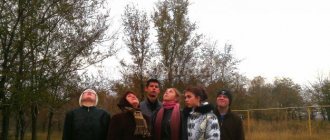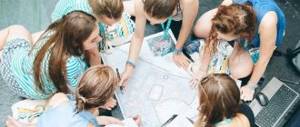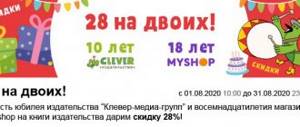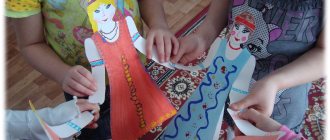Development of creative abilities through theatrical activities (from work experience)
Bibliographic description:
Petushchenko, E. S. Development of creative abilities through theatrical activities (from work experience) / E. S. Petushchenko. — Text: direct // Questions of preschool pedagogy. - 2017. - No. 3 (9). — P. 97-99. — URL: https://moluch.ru/th/1/archive/63/2557/ (date of access: 10.10.2020).
One of the main directions of child development in preschool age is the enrichment of his social and communicative experience. Children's theatrical activities are traditionally considered an effective means of socialization, development of emotional expressiveness of speech, creativity, and curiosity of preschool children.
“ program , built in accordance with the Federal State Educational Standard, defines the main integrative qualities of a preschool child, such as: inquisitive, active, proactive, emotionally responsive, mastering the means of communication and ways of interacting with peers and adults, who are actively developing in theatrical activities. Why theatrical activities? This is one of the most effective ways of influencing children, in which the principle of learning is most fully and clearly demonstrated: learn by playing.
Theatrical and play activities are of great importance for the development of the creative abilities of older preschoolers. Theatrical and gaming activities allow solving issues of personality development: activation of the vocabulary, development of monologue and dialogic speech, the ability to organize communication with peers in order to be interesting to others, the ability to externally express one’s inner emotions and correctly understand the emotional state of the interlocutor.
The author began her work on developing creative abilities through theatrical activities by creating a subject-spatial environment. The group created a “Seclusion Corner” where the child could be alone and cope with his emotions. An “Emotions Corner” was created next to the corner of solitude. It contains a large mirror, a mood diary in which children can place their photographs, determining their mood at different times in kindergarten, and a multifunctional “Mood Cube” manual. It can be used for facial expressions of emotions, their verbal designation, composing stories from personal experience that evoked the mood depicted on a certain side of the cube, the “Miracle Bag”, the sides of which reflect different moods. To introduce children to emotions, the author uses pictograms and signal cards to indicate his attitude towards a fairy tale, game character, the actions of heroes of literary works, and events in the lives of children. The group also created a “Fairy Tale Corner”. It has a small portable screen, different types of theaters (finger, glove, mitten, bi-ba-bo, shadow, plane, toy theater), various games based on fairy tales: “Favorite fairy tales”, “Fold a fairy tale”, “Tell a fairy tale” , “Fairy tales” (from cubes), “Tale by tale”, “Stories in pictures” (sequential plotting). In the corner there is a fairy-tale chest in which children's masks, costumes, hats, etc. are stored. A storyteller was made from a large scarf, who comes to children's classes and tells fairy tales.
In his work the author uses the following methods:
− diction exercises (articulation gymnastics);
− tasks for the development of speech intonation expressiveness;
− transformation games, figurative exercises;
− exercises for the development of children's plasticity;
- rhythmic minutes;
− finger games;
− exercises for the development of expressive facial expressions, elements of pantomime;
− theatrical sketches;
− acting out mini-dialogues, nursery rhymes, songs, poems;
− watching puppet shows.
All these methods are used as part of educational activities, in children’s independent play activities, and in routine moments. The result of the work is productions of performances, open classes with elements of theatrical activities.
Fragment of educational activities:
The teacher dresses the Storyteller and says: I have told you many fairy tales, and today I invite you on a journey through fairy tales.
− What fairy tales do you know? (children call fairy tales)
Today we ourselves will become fairy-tale heroes. But what kind of fairy tale you will now learn. The storyteller makes riddles of the heroes of the fairy tale “Teremok”. “What fairy tale are all these heroes from?” In order to play a fairy tale, you need to complete the tasks that the heroes have prepared for us.
The little mouse was the first to come running into the little house. She asks you to portray her as sad, cheerful, surprised, etc. The mouse chooses the child who best portrayed it with facial expressions and gestures and puts a Mouse cap on him.
- Who was the second to run into the tower? (frog frog)
The frog loves to travel. Therefore, she will now show you, and you must guess what she wants to tell you about. The game “We won’t tell you where we were, but we’ll show you what we did” is being played. The frog chooses a child and puts on a frog hat.
- Who came running into the tower next? (runaway bunny). The bunny invites you all to turn into little bunnies. The finger game “Bunny” is being played
The little bunny got up early
He went out into the clearing.
I walked along the edge of the forest to the forest (we walk with our fingers on the table)
And he found a big head of cabbage (fist of the other hand)
Became a bunny with a crunch
Nibble on a head of cabbage:
Crunch-crunch, crunch-crunch... (make biting movements with several fingers)
Ate it, fell under a bush
And fell asleep. Awoke…
Stretched sweetly (with effort we spread all our fingers)
And when I got home I took a long breath! (with two fingers we show how the hare moves on the table).
The best baby bunny wears a little bunny hat.
- Who came running into the tower next? (fox-sister). The little fox is cunning and wants to test how beautifully you can speak. Children pronounce tongue twisters.
- The red fox licked everyone’s faces.
- The fox runs along the six, lick, fox, sand.
The child wears a fox hat.
- Who came running into the tower next? (top - gray barrel). The wolf was an artist today and drew a lot of forest inhabitants, and the prankish bunnies cut up his pictures. So he came to us for help. Game "Cut-out pictures based on fairy tales."
- Who came running into the tower next? (toed bear). The outdoor game “At the Bear in the Forest” is played. The most dexterous person wears a bear hat.
So all the heroes of the fairy tale “Teremok” have gathered here. The rest of the children make a circle and pretend to be a tower, pronouncing the words. Dramatization of the fairy tale "Teremok".
At the end of the fairy tale, a problematic question is posed to the children: “What should we do? What should we do? It is necessary to make children want to build a new tower. Children are building a new tower to the tune of a Russian folk melody.
- Get up guys in a round dance, we’ll dance.
Then all the children stand in a circle, dance in a circle, and the fairy tale ends with the words:
There is a teremok, teremok in the field,
He is very, very tall, oh, tall.
You can't live here without fun,
Friends live in the mansion!
In working with parents, the author strives to achieve such a relationship when they become active assistants in the development of children's speech. The author provides consultations, advice and recommendations for parents. Selects interesting and accessible games, tasks, and exercises that they could use independently at home. Parents provide great assistance in making scenery, costumes and attributes for fairy tales.
Thus, theatrical activities are one of the tools for developing creative abilities in children of senior preschool age.
Literature:
- Artemova A.V. Theatrical games for preschoolers. Moscow: Education, 1991.
- Antipina E. A. Theatrical activities in kindergarten: Games, exercises, scenarios. - M.: TC Sfera, 2003. - 128 p.
- https://numama.ru
Key terms
(automatically generated)
: child, fairy tale, theatrical activity, little house, preschool age, what kind of fairy tale, development, theatrical play activity, exercise.




